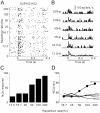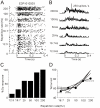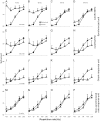Neural responses in the primary auditory cortex of freely behaving cats while discriminating fast and slow click-trains
- PMID: 21998717
- PMCID: PMC3187818
- DOI: 10.1371/journal.pone.0025895
Neural responses in the primary auditory cortex of freely behaving cats while discriminating fast and slow click-trains
Abstract
Repeated acoustic events are ubiquitous temporal features of natural sounds. To reveal the neural representation of the sound repetition rate, a number of electrophysiological studies have been conducted on various mammals and it has been proposed that both the spike-time and firing rate of primary auditory cortex (A1) neurons encode the repetition rate. However, previous studies rarely examined how the experimental animals perceive the difference in the sound repetition rate, and a caveat to these experiments is that they compared physiological data obtained from animals with psychophysical data obtained from humans. In this study, for the first time, we directly investigated acoustic perception and the underlying neural mechanisms in the same experimental animal by examining spike activities in the A1 of free-moving cats while performing a Go/No-go task to discriminate the click-trains at different repetition rates (12.5-200 Hz). As reported by previous studies on passively listening animals, A1 neurons showed both synchronized and non-synchronized responses to the click-trains. We further found that the neural performance estimated from the precise temporal information of synchronized units was good enough to distinguish all 16.7-200 Hz from the 12.5 Hz repetition rate; however, the cats showed declining behavioral performance with the decrease of the target repetition rate, indicating an increase of difficulty in discriminating two slower click-trains. Such behavioral performance was well explained by the firing rate of some synchronized and non-synchronized units. Trial-by-trial analysis indicated that A1 activity was not affected by the cat's judgment of behavioral response. Our results suggest that the main function of A1 is to effectively represent temporal signals using both spike timing and firing rate, while the cats may read out the rate-coding information to perform the task in this experiment.
Conflict of interest statement
Figures









Similar articles
-
Behavioral modulation of neural encoding of click-trains in the primary and nonprimary auditory cortex of cats.J Neurosci. 2013 Aug 7;33(32):13126-37. doi: 10.1523/JNEUROSCI.1724-13.2013. J Neurosci. 2013. PMID: 23926266 Free PMC article.
-
A comparison of neural responses in the primary auditory cortex, amygdala, and medial prefrontal cortex of cats during auditory discrimination tasks.J Neurophysiol. 2019 Mar 1;121(3):785-798. doi: 10.1152/jn.00425.2018. Epub 2019 Jan 16. J Neurophysiol. 2019. PMID: 30649979
-
Neural and behavioral discrimination of sound duration by cats.J Neurosci. 2009 Dec 16;29(50):15650-9. doi: 10.1523/JNEUROSCI.2442-09.2009. J Neurosci. 2009. PMID: 20016079 Free PMC article.
-
Representation of temporal sound features in the human auditory cortex.Rev Neurosci. 2011;22(2):187-203. doi: 10.1515/RNS.2011.016. Rev Neurosci. 2011. PMID: 21476940 Review.
-
Neural coding of temporal information in auditory thalamus and cortex.Neuroscience. 2008 Jun 12;154(1):294-303. doi: 10.1016/j.neuroscience.2008.03.065. Epub 2008 Apr 7. Neuroscience. 2008. Corrected and republished in: Neuroscience. 2008 Nov 19;157(2):484-94. doi: 10.1016/j.neuroscience.2008.07.050. PMID: 18555164 Free PMC article. Corrected and republished. Review.
Cited by
-
Cortical speech-evoked response patterns in multiple auditory fields are correlated with behavioral discrimination ability.J Neurophysiol. 2013 Jul;110(1):177-89. doi: 10.1152/jn.00092.2013. Epub 2013 Apr 17. J Neurophysiol. 2013. PMID: 23596332 Free PMC article.
-
Encoding frequency contrast in primate auditory cortex.J Neurophysiol. 2014 Jun 1;111(11):2244-63. doi: 10.1152/jn.00878.2013. Epub 2014 Mar 5. J Neurophysiol. 2014. PMID: 24598525 Free PMC article.
-
Evoked Response Strength in Primary Auditory Cortex Predicts Performance in a Spectro-Spatial Discrimination Task in Rats.J Neurosci. 2019 Jul 31;39(31):6108-6121. doi: 10.1523/JNEUROSCI.0041-18.2019. Epub 2019 Jun 7. J Neurosci. 2019. PMID: 31175214 Free PMC article.
-
Rapid spectrotemporal plasticity in primary auditory cortex during behavior.J Neurosci. 2014 Mar 19;34(12):4396-408. doi: 10.1523/JNEUROSCI.2799-13.2014. J Neurosci. 2014. PMID: 24647959 Free PMC article.
-
Recognition of Modified Conditioning Sounds by Competitively Trained Guinea Pigs.Front Behav Neurosci. 2016 Jan 26;9:373. doi: 10.3389/fnbeh.2015.00373. eCollection 2015. Front Behav Neurosci. 2016. PMID: 26858617 Free PMC article.
References
-
- Rosen S. Temporal information in speech: acoustic, auditory and linguistic aspects. Philos Trans R Soc Lond B Biol Sci. 1992;336:367–373. - PubMed
-
- Singh NC, Theunissen FE. Modulation spectra of natural sounds and ethological theories of auditory processing. J Acoust Soc Am. 2003;114:3394–3411. - PubMed
-
- Joris PX, Schreiner CE, Rees A. Neural processing of amplitude-modulated sounds. Physiol Rev. 2004;84:541–577. - PubMed
-
- Kay RH. Hearing of modulation in sounds. Physiol Rev. 1982;62:894–975. - PubMed
-
- De Ribaupierre F, Goldstein MH, Jr, Yeni-Komshian G. Cortical coding of repetitive acoustic pulses. Brain Res. 1972;48:205–225. - PubMed
Publication types
MeSH terms
LinkOut - more resources
Full Text Sources
Research Materials
Miscellaneous

